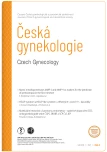Molecular classification of endometrial cancers translated into practice
Authors:
Presl J. 1; Vaněček T. 2; Michal M. 2; Bouda J. 1; Kosťun J. 1; Vlasák P. 1; Stráník P. 1
Authors‘ workplace:
Gynekologicko-porodnická klinika LF UK a FN Plzeň
1; Bioptická laboratoř s. r. o., Plzeň
2
Published in:
Ceska Gynekol 2021; 86(4): 258-262
Category:
Review Article
doi:
https://doi.org/10.48095/cccg2021258
Overview
Objective: The main objective of the article is to clearly inform healthcare professionals about the newly implemented molecular classification of endometrial cancer into practice. Methods: Summary of current knowledge, recommendations and new procedures relating to molecular genetic examination of the tissues of patients with endometrial carcinoma. Results: Endometrial cancer is currently diagnosed on the base of histopathological morphology. According to the classical Bokhman division, we distinguish between two relatively wide groups of tumors which are different in pathogenesis: type I – estrogen-dependent tumors, clinically usually indolent, and type II – non-endometroid tumors, clinically aggressive, without dependence on estrogen stimulation. This classification fulfills a didactic purpose and provides easy orientation for epidemiological data, but is not suitable for stratification due to the overlap of clinical, pathological and molecular features. The Cancer Genome Atlas project classifies endometrial tumors into 4 groups based on molecular genetic features. Conclusion: Integration of the histopathological findings along with molecular classification appears to be the best approach for evaluating each individual tumor. This will help to achieve the ideal stratification of patients for treatment regimens.
Keywords:
Endometrial carcinoma – molecular classification – The Cancer Genome Atlas project – POLE mutation –mismatch repair-deficient tumors – non-specific molecular profile – TP53 mutation
Sources
1. Bokhman JV. Two pathogenetic types of endometrial carcinoma. Gynecol Oncol 1983; 15 (1): 10–17. doi: 10.1016/0090-8258 (83) 90111-7.
2. Kandoth C, Schultz N, Cherniack AD et al. Cancer Genome Atlas Research Network. Integrated genomic characterization of endometrial carcinoma. Nature 2013; 497 (7447): 67–73. doi: 10.1038/nature12113.
3. van Gool IC, Eggink FA, Freeman-Mills L et al. POLE proofreading mutations elicit an antitumor immune response in endometrial cancer. Clin Cancer Res 2015; 21 (14): 3347–3355. doi: 10.1158/1078-0432.CCR-15-0057.
4. Howitt BE, Shukla SA, Sholl LM et al. Association of polymerase e-mutated and microsatellite-instable endometrial cancers with neoantigen load, number of tumor-infiltrating lymphocytes, and expression of PD-1 and PD-L1. JAMA Oncol 2015; 1 (9): 1319–1323. doi: 10.1001/jamaoncol.2015.2151.
5. Stelloo E, Nout RA, Osse EM et al. Improved risk assessment by integrating molecular and clinicopathological factors in early-stage endometrial cancer-combined analysis of the PORTEC cohorts. Clin Cancer Res 2016; 22 (16): 4215–4224. doi: 10.1158/1078-0432.CCR-15-2 878.
6. Horeweg N, de Bruyn M, Nout RA et al. Prognostic integrated image-based immune and molecular profiling in early-stage endometrial cancer. Cancer Immunol Res 2020; 8 (12): 1508–1519. doi: 10.1158/2326-6066.CIR-20-0149.
7. León-Castillo A, de Boer SM, Powell ME et al. Molecular classification of the PORTEC-3 trial for high-risk endometrial cancer: impact on prognosis and benefit from adjuvant therapy. J Clin Oncol 2020; 38 (29): 3388–3397. doi: 10.1200/JCO.20.00549.
8. Banet N, Shahi M, Batista D et al. HER-2 amplification in uterine serous carcinoma and serous endometrial intraepithelial carcinoma. Am J Surg Pathol 2021; 45 (5): 708–715. doi: 10.1097/PAS.0000000000001682.
9. Rubinstein MM, Hyman DM, Caird I et al. Phase 2 study of LY3023414 in patients with advanced endometrial cancer harboring activating mutations in the PI3K pathway. Cancer 2020; 126 (6): 1274–1282. doi: 10.1002/cncr.32677.
10. Talhouk A, McConechy MK, Leung S et al. A clinically applicable molecular-based classification for endometrial cancers. Br J Cancer 2015; 113 (2): 299–310. doi: 10.1038/bjc.2015.190.
11. Marnitz S, Waltar T, Köhler C et al. The brave new world of endometrial cancer: future implications for adjuvant treatment decisions. Strahlenther Onkol 2020; 196 (11): 963–972. doi: 10.1007/s00066-020-01632-w.
12. Wortman BG, Bosse T, Nout RA et al. Molecular-integrated risk profile to determine adjuvant radiotherapy in endometrial cancer: evaluation of the pilot phase of the PORTEC-4a trial. Gynecol Oncol 2018; 151 (1): 69–75. doi: 10.1016/j.ygyno.2018.07.020.
13. Concin N, Creutzberg CL, Vergote I et al. ESGO/ESTRO/ESP Guidelines for the management of patients with endometrial carcinoma. Virchows Arch 2021; 478 (2): 153–190. doi: 10.1007/s00428-020-03007-z.
14. Vermij L, Smit V, Nout R et al. Incorporation of molecular characteristics into endometrial cancer management. Histopathology 2020; 76 (1): 52–63. doi: 10.1111/his.14015.
Labels
Paediatric gynaecology Gynaecology and obstetrics Reproduction medicineArticle was published in
Czech Gynaecology

2021 Issue 4
Most read in this issue
- Pelvic neuropathic pain (differential diagnosis)
- HELLP syndrome and HELLP-like syndrome in pregnancies with covid-19 – case reports
- Molecular testing in endometrial carcinoma – joint recommendation of Czech Oncological Society, Oncogynecological Section of the Czech Gynecological and Obstetrical Society, Society of Radiation Oncology, Biology and Physics, and the Society of Czech Pathologists
- Recurrence of rare malignant Brenner ovarian tumor
